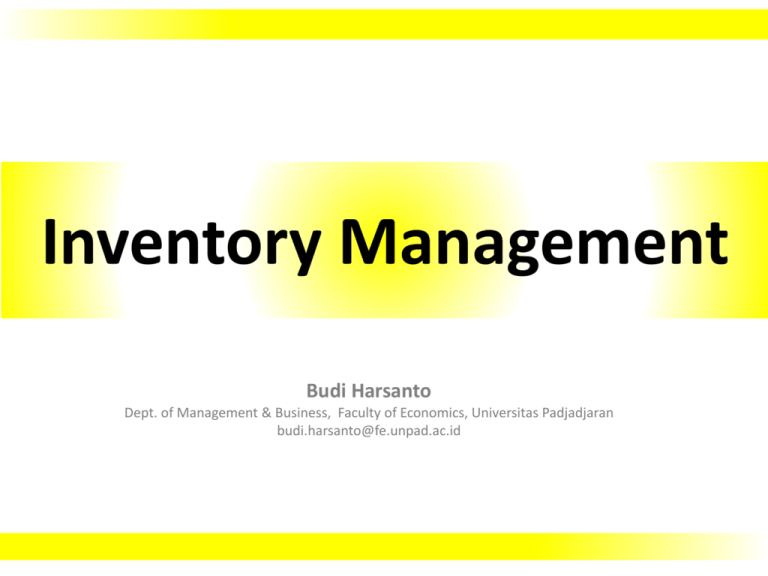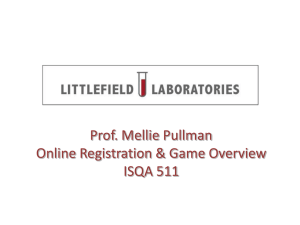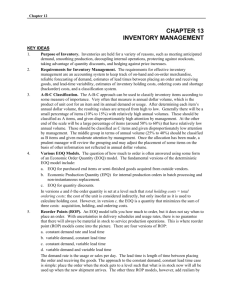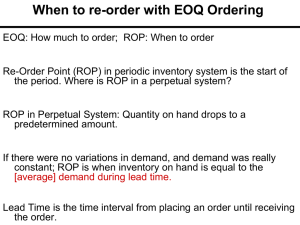Operations Management - Blogs Unpad
advertisement

Inventory Management Budi Harsanto Dept. of Management & Business, Faculty of Economics, Universitas Padjadjaran budi.harsanto@fe.unpad.ac.id Today Outline • INVENTORY MANAGEMENT – Probabilistic Models and Safety Stock – Single Period Model 2 Operations Management Chapter 12 – Inventory Management PowerPoint presentation to accompany Heizer/Render Principles of Operations Management, 7e Operations Management, 9e Inventory Management How inventory items can be classified How accurate inventory records can be maintained Holding, Ordering, and Setup Costs Holding costs - the costs of holding or “carrying” inventory over time Ordering costs - the costs of placing an order and receiving goods Setup costs - cost to prepare a machine or process for manufacturing an order Probabilistic Models and Safety Stock Used when demand is not constant or certain Use safety stock to achieve a desired service level and avoid stockouts ROP = d x L + ss Annual stockout costs = the sum of the units short x the probability x the stockout cost/unit x the number of orders per year Safety Stock Example ROP = 50 units Orders per year = 6 Stockout cost = $40 per frame Carrying cost = $5 per frame per year Number of Units ROP 30 40 50 60 70 Probability .2 .2 .3 .2 .1 1.0 Safety Stock Example ROP = 50 units Orders per year = 6 Stockout cost = $40 per frame Carrying cost = $5 per frame per year Safety Stock Additional Holding Cost 20 (20)($5) = $100 10 (10)($5) = $ 50 (10)(.1)($40)(6) 0 $ Total Cost Stockout Cost $0 $100 = $240 $290 0 (10)(.2)($40)(6) + (20)(.1)($40)(6) = $960 $960 A safety stock of 20 frames gives the lowest total cost ROP = 50 + 20 = 70 frames Probabilistic Demand Inventory level Minimum demand during lead time Maximum demand during lead time Mean demand during lead time ROP = 350 + safety stock of 16.5 = 366.5 ROP Normal distribution probability of demand during lead time Expected demand during lead time (350 kits) Safety stock 0 Figure 12.8 Lead time Place order 16.5 units Time Receive order Probabilistic Demand Risk of a stockout (5% of area of normal curve) Probability of no stockout 95% of the time Mean demand 350 ROP = ? kits Quantity Safety stock 0 z Number of standard deviations Probabilistic Demand Use prescribed service levels to set safety stock when the cost of stockouts cannot be determined ROP = demand during lead time + ZsdLT where Z = number of standard deviations sdLT = standard deviation of demand during lead time Probabilistic Example Average demand = m = 350 kits Standard deviation of demand during lead time = sdLT = 10 kits 5% stockout policy (service level = 95%) Using Appendix I, for an area under the curve of 95%, the Z = 1.65 Safety stock = ZsdLT = 1.65(10) = 16.5 kits Reorder point = expected demand during lead time + safety stock = 350 kits + 16.5 kits of safety stock = 366.5 or 367 kits Other Probabilistic Models When data on demand during lead time is not available, there are other models available 1. When demand is variable and lead time is constant 2. When lead time is variable and demand is constant 3. When both demand and lead time are variable Other Probabilistic Models Demand is variable and lead time is constant ROP = where (average daily demand x lead time in days) + ZsdLT sd = standard deviation of demand per day sdLT = sd lead time Probabilistic Example Average daily demand (normally distributed) = 15 Standard deviation = 5 Lead time is constant at 2 days 90% service level desired Z for 90% = 1.28 From Appendix I ROP = (15 units x 2 days) + Zsdlt = 30 + 1.28(5)( 2) = 30 + 9.02 = 39.02 ≈ 39 Safety stock is about 9 iPods Other Probabilistic Models Lead time is variable and demand is constant ROP = (daily demand x average lead time in days) = Z x (daily demand) x sLT where sLT = standard deviation of lead time in days Probabilistic Example Daily demand (constant) = 10 Average lead time = 6 days Standard deviation of lead time = sLT = 3 98% service level desired Z for 98% = 2.055 From Appendix I ROP = (10 units x 6 days) + 2.055(10 units)(3) = 60 + 61.65 = 121.65 Reorder point is about 122 cameras Other Probabilistic Models Both demand and lead time are variable ROP = where (average daily demand x average lead time) + ZsdLT sd = standard deviation of demand per day sLT = standard deviation of lead time in days sdLT = (average lead time x sd2) + (average daily demand)2 x sLT2 Probabilistic Example Average daily demand (normally distributed) = 150 Standard deviation = sd = 16 Average lead time 5 days (normally distributed) Standard deviation = sLT = 1 day 95% service level desired Z for 95% = 1.65 ROP = (150 packs x 5 days) + 1.65sdLT = (150 x 5) + 1.65 (5 days x 162) + (1502 x 12) = 750 + 1.65(154) = 1,004 packs Fixed-Period (P) Systems Orders placed at the end of a fixed period Inventory counted only at end of period Order brings inventory up to target level Only relevant costs are ordering and holding Lead times are known and constant Items are independent from one another Fixed-Period (P) Systems Target quantity (T) Q4 On-hand inventory Q2 Q1 Q3 P P P Time Figure 12.9 Fixed-Period (P) Example 3 jackets are back ordered It is time to place an order No jackets are in stock Target value = 50 Order amount (Q) = Target (T) - On-hand inventory - Earlier orders not yet received + Back orders Q = 50 - 0 - 0 + 3 = 53 jackets Fixed-Period Systems Inventory is only counted at each review period May be scheduled at convenient times Appropriate in routine situations May result in stockouts between periods May require increased safety stock







